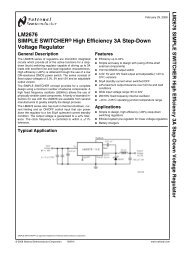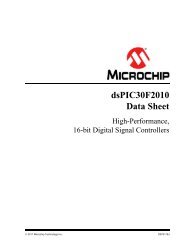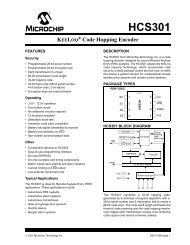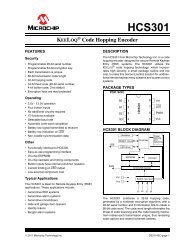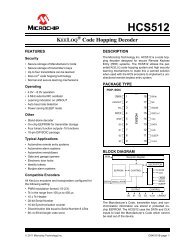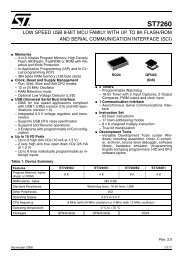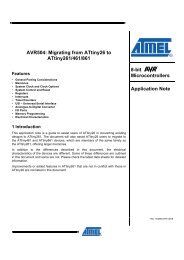LM3433 Common Anode Capable High Brightness LED Driver with ...
LM3433 Common Anode Capable High Brightness LED Driver with ...
LM3433 Common Anode Capable High Brightness LED Driver with ...
You also want an ePaper? Increase the reach of your titles
YUMPU automatically turns print PDFs into web optimized ePapers that Google loves.
March 7, 2008<br />
<strong>LM3433</strong><br />
<strong>Common</strong> <strong>Anode</strong> <strong>Capable</strong> <strong>High</strong> <strong>Brightness</strong> <strong>LED</strong> <strong>Driver</strong> <strong>with</strong><br />
<strong>High</strong> Frequency Dimming<br />
General Description<br />
The <strong>LM3433</strong> is an adaptive constant on-time DC/DC buck<br />
(step-down) constant current controller (a true current<br />
source). The <strong>LM3433</strong> provides a constant current for illuminating<br />
high power <strong>LED</strong>s. The output configuration allows the<br />
anodes of multiple <strong>LED</strong>s to be tied directly to the ground referenced<br />
chassis for maximum heat sink efficacy. The high<br />
frequency capable architecture allows the use of small external<br />
passive components and no output capacitor while maintaining<br />
low <strong>LED</strong> ripple current. Two control inputs are used to<br />
modulate <strong>LED</strong> brightness. An analog current control input is<br />
provided so the <strong>LM3433</strong> can be adjusted to compensate for<br />
<strong>LED</strong> manufacturing variations and/or color temperature correction.<br />
The other input is a logic level PWM control of <strong>LED</strong><br />
current. The PWM functions by shorting out the <strong>LED</strong> <strong>with</strong> a<br />
parallel switch allowing high PWM dimming frequencies. <strong>High</strong><br />
frequency PWM dimming allows digital color temperature<br />
control, interference blanking, field sequential illumination,<br />
and brightness control. Additional features include thermal<br />
shutdown, V CC under-voltage lockout, and logic level shutdown<br />
mode. The <strong>LM3433</strong> is available in a low profile LLP-24<br />
package.<br />
Typical Application Circuit<br />
Features<br />
■ Operating input voltage range of -9V to -14V w.r.t. <strong>LED</strong><br />
anode<br />
■ Control inputs are referenced to the <strong>LED</strong> anode<br />
■ Output current greater than 6A<br />
■ Greater than 30kHz PWM frequency capable<br />
■ Negative output voltage capability allows <strong>LED</strong> anode to be<br />
tied directly to chassis for maximum heat sink efficacy<br />
■ No output capacitor required<br />
■ Up to 1MHz switching frequency<br />
■ Low I Q , 1mA typical<br />
■ Soft start<br />
■ Adaptive programmable ON time allows for constant ripple<br />
current<br />
■ LLP-24 package<br />
Applications<br />
■ LCD backlighting<br />
■ Projection systems<br />
■ Solid state lighting<br />
■ Automotive lighting<br />
30031531<br />
<strong>LM3433</strong> <strong>Common</strong> <strong>Anode</strong> <strong>Capable</strong> <strong>High</strong> <strong>Brightness</strong> <strong>LED</strong> <strong>Driver</strong> <strong>with</strong> <strong>High</strong> Frequency Dimming<br />
© 2008 National Semiconductor Corporation 300315 www.national.com
<strong>LM3433</strong><br />
Connection Diagram<br />
Top View<br />
24-Lead LLP<br />
NS Package Number SQA24A<br />
30031504<br />
Ordering Information<br />
Order Number Spec. Package<br />
Type<br />
NSC Package<br />
Drawing<br />
<strong>LM3433</strong>SQ NOPB LLP-24 SQA24A 1000 Units, Tape and Reel<br />
<strong>LM3433</strong>SQX NOPB LLP-24 SQA24A 4500 Units, Tape and Reel<br />
Pin Descriptions<br />
Pin Name Function<br />
Supplied As<br />
1 T ON (C ON ) from T ON to V EE . This sets the nominal operating frequency when the <strong>LED</strong> is fully<br />
On-time programming pin. Tie an external resistor (R ON ) from T ON to CSN, and a capacitor<br />
illuminated.<br />
2 ADJ<br />
3 EN<br />
Analog <strong>LED</strong> current adjust. Tie to V IN for fixed 60mV average current sense resistor voltage. Tie<br />
to an external reference to adjust the average current sense resistor voltage (programmed output<br />
current). Refer to the "V SENSE vs. ADJ Voltage" graphs in the Typical Performance<br />
Characteristics section and the Design Procedure section of the datasheet.<br />
Enable pin. Connect this pin to logic level HI or V IN for normal operation. Connect this pin to<br />
CGND for low current shutdown. EN is internally tied to V IN through a 100k resistor.<br />
4 DIM Logic level input for <strong>LED</strong> PWM dimming. DIM is internally tied to CGND through a 100k resistor.<br />
5 V IN Logic power input: Connect to positive voltage between +3.0V and +5.8V w.r.t. CGND.<br />
6 CGND Chassis ground connection.<br />
7 V EE Negative voltage power input: Connect to voltage between –14V to –9V w.r.t. CGND.<br />
8 COMP Compensation pin. Connect a capacitor between this pin and V EE .<br />
9 NC No internal connection. Tie to V EE or leave open.<br />
10 SS<br />
Soft Start pin. Tie a capacitor from SS to V EE to reduce input current ramp rate. Leave pin open<br />
if function is not used. The SS pin is pulled to V EE when the device is not enabled.<br />
11 NC No internal connection. Tie to V EE or leave open.<br />
12 NC No internal connection. Tie to V EE or leave open.<br />
13 LS Low side FET gate drive return pin.<br />
14 LO Low side FET gate drive output. Low in shutdown.<br />
www.national.com 2
Pin Name Function<br />
15 V CC<br />
Low side FET gate drive power bypass connection and boost diode anode connection. Tie a<br />
2.2µF capacitor between V CC and V EE .<br />
16 BST <strong>High</strong> side "synchronous" FET drive bootstrap rail.<br />
17 HO <strong>High</strong> side "synchronous" FET gate drive output. Pulled to HS in shutdown.<br />
18 HS Switching node and high side "synchronous" FET gate drive return.<br />
19 DIMR <strong>LED</strong> dimming FET gate drive return. Tie to <strong>LED</strong> cathode.<br />
20 DIMO <strong>LED</strong> dimming FET gate drive output. DIMO is a driver that switches between DIMR and BST2.<br />
21 BST2 DIMO high side drive supply pin. Tie a 0.1µF between BST2 and CGND.<br />
22 NC No internal connection. Tie to V EE or leave open.<br />
23 CSN Current sense amplifier inverting input. Connect to current sense resistor negative terminal.<br />
24 CSP Current sense amplifier non-inverting input. Connect to current sense resistor positive terminal.<br />
EP V EE<br />
Exposed Pad on the underside of the device. Connect this pad to a PC board plane connected<br />
to V EE .<br />
<strong>LM3433</strong><br />
Block Diagram<br />
30031503<br />
3 www.national.com
<strong>LM3433</strong><br />
Absolute Maximum Ratings (Note 1)<br />
If Military/Aerospace specified devices are required,<br />
please contact the National Semiconductor Sales Office/<br />
Distributors for availability and specifications.<br />
V IN , EN, DIM, ADJ to CGND -0.3V to +7V<br />
COMP, SS to V EE -0.3V to +7V<br />
BST to HS -0.3V to +7V<br />
V CC to V EE<br />
-0.3V to +7.5V<br />
CGND, DIMR, CSP, CSN,<br />
T ON to V EE -0.3V to +16V<br />
HS to V EE (Note 2) -0.3V to +16V<br />
LS to V EE<br />
-0.3V to +0.3V<br />
HO output<br />
HS-0.3V to BST+0.3V<br />
DIMO to DIMR -0.3V to +7V<br />
LO output<br />
LS-0.3V to V CC +0.3V<br />
BST2 to V EE -0.3V to 22.0V<br />
Maximum Junction<br />
150°C<br />
Temperature<br />
Power Dissipation(Note 3)<br />
ESD Susceptibility<br />
(Note 4)<br />
Human Body Model<br />
Machine Model<br />
Charge Device Model<br />
Operating Conditions<br />
Internally Limited<br />
2kV<br />
200V<br />
1kV<br />
Operating Junction<br />
Temperature Range (Note 5)<br />
−40°C to +125°C<br />
Storage Temperature<br />
−65°C to +150°C<br />
Input Voltage V IN w.r.t. CGND 3.0V to 5.8V<br />
Input Voltage V EE w.r.t. CGND -9V to -14V<br />
ADJ Input Voltage Range to<br />
CGND<br />
CSP, CSN <strong>Common</strong> Mode<br />
Range With Respect to CGND<br />
0V to V IN<br />
-6V to 0V<br />
Electrical Characteristics<br />
Specifications in standard type face are for T J = 25°C and those <strong>with</strong> boldface type apply over the full Operating Temperature<br />
Range ( T J = −40°C to +125°C). Minimum and Maximum limits are guaranteed through test, design, or statistical correlation. Typical<br />
values represent the most likely parametric norm at T J = +25ºC, and are provided for reference purposes only. Unless otherwise<br />
stated the following conditions apply: V EE = -12.0V and V IN = +3.3V <strong>with</strong> respect to CGND.<br />
Symbol Parameter Conditions Min(Note 5) Typ(Note 6) Max(Note 5) Units<br />
SUPPLY CURRENT<br />
I IN V EE V EE Quiescent Current EN = CGND 3 19 µA<br />
EN = V IN , Not Switching 1.0 mA<br />
I IN V IN V IN Quiescent Current EN = V IN , Not Switching 300<br />
OUTPUT CURRENT CONTROL<br />
V CS<br />
G ADJ<br />
EN = CGND 35 71<br />
Current sense target voltage;<br />
V CS = V CSP – V CSN<br />
V ADJ = V IN<br />
57 60 63 mV<br />
I ADJ Gain = (V ADJ -CGND)/<br />
(V CNP -V CSN )<br />
V IN = 3.3V, V ADJ = 0.5V or 1.5V<br />
w.r.t. CGND<br />
I CSN Isense Input Current V ADJ = 1V w.r.t. CGND -50<br />
V ADJ = V IN 10<br />
I CSP Isense Input Current V ADJ = V IN 60<br />
Gm<br />
ON TIME CONTROL<br />
CS to COMP<br />
Transconductance; Gm =<br />
I COMP / (V CSP – V CSN - V ADJ /<br />
16.67)<br />
V ADJ = 1V w.r.t. CGND 1<br />
T ONTH On time threshold V TON<br />
- V EE at terminate ON time<br />
GATE DRIVE AND INTERNAL REGULATOR<br />
event<br />
µA<br />
15 16.67 18 V/V<br />
µA<br />
µA<br />
0.6 1.3 2.2 mS<br />
230 287 334 mV<br />
V CCOUT V CC output regulation w.r.t. V EE I CC = 0mA to 20mA 6.3 6.75 7.1 V<br />
V CCILIM V CC current limit V CC = V EE 33 53 mA<br />
R OLH HO output low resistance I = 50mA source 2<br />
R OHH HO output high resistance I = 50mA sink 3<br />
R OLL LO output low resistance I = 50mA source 2<br />
R OHL LO output high resistance I = 50mA sink 3<br />
Ω<br />
Ω<br />
www.national.com 4
Symbol Parameter Conditions Min(Note 5) Typ(Note 6) Max(Note 5) Units<br />
R OLP DIMO output low resistance I = 5mA source 20<br />
R OHP DIMO output high resistance I = 5mA sink 30<br />
FUNCTIONAL CONTROL<br />
V INUVLO V IN undervoltage lockout With respect to CGND 1.4 V<br />
V CCUVLO<br />
V EN<br />
V CC - V EE undervoltage lockout<br />
thresholds<br />
Enable threshold, <strong>with</strong> respect<br />
to CGND<br />
On Threshold 6.0 6.6 7.0<br />
Off threshold 4.9 5.4 5.8<br />
Device on w.r.t. CGND 1.6<br />
Device off w.r.t. CGND 0.6<br />
R EN Enable pin pullup resistor 100 kΩ<br />
V DIM DIM logic input threshold DIM rising threshold w.r.t.<br />
CGND<br />
DIM falling threshold w.r.t.<br />
CGND<br />
R DIM DIM pin pulldown resistor 100 kΩ<br />
I ADJ ADJ pin current -1.0 1.0 µA<br />
I SS SS pin source current 10 µA<br />
R SS SS pin pulldown resistance EN = CGND 1.0 kΩ<br />
AC SPECIFICATIONS<br />
T DTD LO and HO dead time LO falling to HO rising dead<br />
time<br />
T PDIM<br />
DIM to DIMO propagation<br />
delay<br />
THERMAL SPECIFICATIONS<br />
T JLIM<br />
Junction temperature thermal<br />
limit<br />
HO falling to LO rising dead<br />
time<br />
DIM rising to DIMO rising delay 68 124<br />
DIM falling to DIMO falling<br />
delay<br />
0.6<br />
26<br />
28<br />
1.6<br />
58 160<br />
Ω<br />
V<br />
V<br />
V<br />
ns<br />
ns<br />
175 °C<br />
T JLIM(hyst) Thermal limit hysteresis 20 °C<br />
θ JA<br />
LLP-24 package thermal<br />
resistance<br />
JEDEC 4 layer board<br />
39 °C/W<br />
<strong>LM3433</strong><br />
Note 1: Absolute maximum ratings are limits beyond which damage to the device may occur. Operating Ratings are conditions for which the device is intended<br />
to be functional, but device parameter specifications may not be guaranteed. For guaranteed specifications and test conditions, see the Electrical Characteristics.<br />
Note 2: The HS pin can go to -6V <strong>with</strong> respect to V EE for 30ns and +22V <strong>with</strong> respect to V EE for 50ns <strong>with</strong>out sustaining damage.<br />
Note 3: The maximum allowable power dissipation is a function of the maximum junction temperature, T J (MAX), the junction-to-ambient thermal resistance,<br />
θ JA , and the ambient temperature, T A . The maximum allowable power dissipation at any ambient temperature is calculated using: P D (MAX) = (T J(MAX) − T A )/<br />
θ JA . Exceeding the maximum allowable power dissipation will cause excessive die temperature, and the regulator will go into thermal shutdown. Internal thermal<br />
shutdown circuitry protects the device from permanent damage. Thermal shutdown engages at T J =175°C (typ.) and disengages at T J =155°C (typ).<br />
Note 4: Human Body Model, applicable std. JESD22-A114-C. Machine Model, applicable std. JESD22-A115-A. Field Induced Charge Device Model, applicable<br />
std. JESD22-C101-C.<br />
Note 5: All limits guaranteed at room temperature (standard typeface) and at temperature extremes (bold typeface). All room temperature limits are 100%<br />
production tested. All limits at temperature extremes are guaranteed via correlation using standard Statistical Quality Control (SQC) methods. All limits are used<br />
to calculate Average Outgoing Quality Level (AOQL).<br />
Note 6: Typical numbers are at 25°C and represent the most likely norm.<br />
5 www.national.com
<strong>LM3433</strong><br />
Typical Performance Characteristics<br />
Efficiency vs. <strong>LED</strong> Forward Voltage<br />
(V CGND -V EE = 9V)<br />
Efficiency vs. <strong>LED</strong> Forward Voltage<br />
(V CGND -V EE = 12V)<br />
Efficiency vs. <strong>LED</strong> Forward Voltage<br />
(V CGND -V EE = 14V)<br />
30031523<br />
V SENSE vs. V ADJ<br />
(V IN = 3.3V)<br />
30031522<br />
V SENSE vs. V ADJ<br />
(V IN = 5.0V)<br />
30031521<br />
V SENSE vs. Temperature<br />
(ADJ = V IN )<br />
30031518<br />
30031519<br />
30031524<br />
www.national.com 6
V SENSE vs. Temperature<br />
(ADJ = 1.0V)<br />
Average <strong>LED</strong> Current vs. DIM Duty Cycle<br />
(30kHz dimming, I <strong>LED</strong> = 6A nominal)<br />
<strong>LM3433</strong><br />
30031525<br />
30031520<br />
Startup Waveform<br />
Shutdown Waveform<br />
30031567<br />
I <strong>LED</strong> = 6A nominal, V IN = 3.3V, V EE = -12V, V <strong>LED</strong> = 3V, SS = open<br />
Top trace: EN input, 2V/div, DC<br />
Middle trace: V EE input current, 2A/div, DC<br />
Bottom trace: I <strong>LED</strong> , 2A/div, DC<br />
T = 100µs/div<br />
30031568<br />
I <strong>LED</strong> = 6A nominal, V IN = 3.3V, V EE = -12V, V <strong>LED</strong> = 3V, SS = open<br />
Top trace: EN input, 2V/div, DC<br />
Middle trace: V EE input current, 2A/div, DC<br />
Bottom trace: I <strong>LED</strong> , 2A/div, DC<br />
T = 100µs/div<br />
30kHz PWM Dimming Waveform Showing Inductor Ripple<br />
Current<br />
I <strong>LED</strong> = 6A nominal, V IN = 3.3V, V EE = -12V<br />
Top trace: DIM input, 2V/div, DC<br />
Bottom trace: I <strong>LED</strong> , 2A/div, DC<br />
T = 10µs/div<br />
30031566<br />
7 www.national.com
<strong>LM3433</strong><br />
Operation<br />
CURRENT REGULATOR OPERATION<br />
The <strong>LM3433</strong> is a controller for a Continuous Conduction Buck<br />
Converter. Because of its buck topology and operation in the<br />
continuous mode, the output current is very well controlled. It<br />
only varies <strong>with</strong>in a switching frequency cycle by the inductor<br />
ripple current. This ripple current is normally set at 10% of the<br />
DC current. Setting the ripple current lower than 10% is a<br />
useful tradeoff of inductor size for less <strong>LED</strong> light output ripple.<br />
Additional circuitry can be added to achieve any <strong>LED</strong> light<br />
ripple desired.<br />
The <strong>LED</strong> current is set by the voltage across a sense resistor.<br />
This sense voltage is nominally 60mV but can be programmed<br />
higher or lower by an external control voltage.<br />
The running frequency of the converter is programmed by an<br />
external RC network in conjunction <strong>with</strong> the <strong>LED</strong>'s forward<br />
voltage. The frequency is nominally set around 200kHz to<br />
500khz. Fast PWM control is available by shorting the output<br />
of the current source by a MOSFET in parallel <strong>with</strong> the <strong>LED</strong>.<br />
During the <strong>LED</strong> OFF time the running frequency is determined<br />
by the RC network and the parasitic resistance of the output<br />
circuit including the DIM FET R DSON .<br />
The <strong>LM3433</strong> system has been evaluated to be a very accurate,<br />
high compliance current source. This is manifest in its<br />
high output impedance and accurate current control. The current<br />
is measured to vary less than 6mA out of 6A when<br />
transitioning from <strong>LED</strong> OFF (output shorted) to <strong>LED</strong> ON (output<br />
~6V).<br />
PROTECTION<br />
The <strong>LM3433</strong> has dedicated protection circuitry running during<br />
normal operation. The thermal shutdown circuitry turns off all<br />
power devices when the die temperature reaches excessive<br />
levels. The V CC undervoltage lockout (UVLO) comparator<br />
protects the power devices during power supply startup and<br />
shutdown to prevent operation at voltages less than the minimum<br />
operating input voltage. The V CC pin is short circuit<br />
protected to V EE . The <strong>LM3433</strong> also features a shutdown mode<br />
which decreases the supply current to approximately 35µA.<br />
The ADJ, EN, and DIM pins are capable of sustaining up to<br />
+/-2mA. If the voltages on these pins will exceed either V IN or<br />
CGND by necessity or by a potential fault, an external resistor<br />
is recommended for protection. Size this resistor to limit pin<br />
current to under 2mA. A 10k resistor should be sufficient. This<br />
resistor may be used in any application for added protection<br />
<strong>with</strong>out any impact on function or performance.<br />
DESIGN PROCEDURE<br />
This section presents guidelines for selecting external components.<br />
SETTING <strong>LED</strong> CURRENT CONTROL<br />
<strong>LM3433</strong> uses average current mode control to regulate the<br />
current delivered to the <strong>LED</strong> (I <strong>LED</strong> ). An external current sense<br />
resistor (R SENSE ) in series <strong>with</strong> the <strong>LED</strong> is used to convert<br />
I <strong>LED</strong> into a voltage that is sensed by the <strong>LM3433</strong> at the CSP<br />
and CSN pins. CSP and CSN are the inputs to an error amplifier<br />
<strong>with</strong> a programmed input offset voltage (V SENSE ).<br />
V SENSE is used to regulate I <strong>LED</strong> based on the following equation:<br />
FIXED <strong>LED</strong> CURRENT<br />
The ADJ pin sets V SENSE . Tie ADJ to V IN to use a fixed 60mV<br />
internal reference for V SENSE . Select R SENSE to fix the <strong>LED</strong><br />
current based on the following equation:<br />
ADJUSTABLE <strong>LED</strong> CURRENT<br />
When tied to an external voltage the ADJ pin sets V SENSE<br />
based on the following equation:<br />
When the reference on ADJ is adjustable, V SENSE and I <strong>LED</strong><br />
can be adjusted <strong>with</strong>in the linear range of the ADJ pin. This<br />
range has the following limitations:<br />
When V ADJ is less than this linear range the V SENSE is guaranteed<br />
by design to be less than or equal to 0.3V/16.667.<br />
When V ADJ is greater than this linear range and less than<br />
V IN - 1V, V SENSE is guaranteed by design to be less than or<br />
equal to V ADJ /16.667. If V ADJ is greater than V IN - 1V,<br />
V SENSE switches to 60mV.<br />
INPUT CAPACITOR SELECTION<br />
A low ESR ceramic capacitor is needed to bypass the MOS-<br />
FETs. This capacitor is connected between the drain of the<br />
synchronous FET (CGND) and the source of the main switch<br />
(V EE ). This capacitor prevents large voltage transients from<br />
appearing at the V EE pin of the <strong>LM3433</strong>. Use a 22µF value<br />
minimum <strong>with</strong> X5R or X7R dielectric. In addition to the FET<br />
bypass capacitors, additional bypass capacitors should be<br />
placed near the V EE and V IN pins and should be returned to<br />
CGND.<br />
The input capacitor must also be sized to handle the dimming<br />
frequency input ripple when the DIM function is used. This<br />
ripple may be as high as 85% of the nominal DC input current<br />
(at 50% duty cycle). When dimming this input capacitor<br />
should be selected to handle the input ripple current.<br />
RECOMMENDED OPERATING FREQUENCY AND ON<br />
TIME "TIME ON " CALCULATION<br />
Although the switching frequency can be set over a wide<br />
range, the following equation describes the recommended<br />
frequency selection given inexpensive magnetic materials<br />
available today:<br />
In the above equation A=1.2 for powdered iron core inductors<br />
and A=0.9 or less for ferrite core inductors. This difference<br />
takes into account the fact that ferrite cores generally become<br />
more lossy at higher frequencies. Given the switching frequency<br />
f calculated above, TIME ON can be calculated. If<br />
V <strong>LED</strong> is the forward voltage drop of the <strong>LED</strong> that is being driven,<br />
TIME ON can be calculated <strong>with</strong> the following equation:<br />
www.national.com 8
TIMING COMPONENTS (R ON and C ON )<br />
Using the calculated value for TIME ON , the timing components<br />
R ON and C ON can be selected. C ON should be large<br />
enough to dominate the parasitic capacitance of the T ON pin.<br />
A good C ON value for most applications is 1nF. Based on calculated<br />
TIME ON , C ON , and the nominal V EE and V <strong>LED</strong> voltages,<br />
R ON can be calculated based on the following equation:<br />
INDUCTOR SELECTION<br />
The most critical inductor parameters are inductance, current<br />
rating, and DC resistance. To calculate the inductance, use<br />
the desired peak to peak <strong>LED</strong> ripple current (I RIPPLE ), R ON ,<br />
and C ON . A reasonable value for I RIPPLE is 10% of I <strong>LED</strong> . The<br />
inductor value is calculated using the following equation:<br />
For all V <strong>LED</strong> and V EE voltages, I RIPPLE remains constant<br />
and is only dependent on the passive external components<br />
R ON , C ON , and L.<br />
The I 2 R loss caused by the DC resistance of the inductor is<br />
an important parameter affecting the efficiency. Lower DC resistance<br />
inductors are larger. A good tradeoff point between<br />
the efficiency and the core size is letting the inductor I 2 R loss<br />
equal 1% to 2% of the output power. The inductor should have<br />
a current rating greater than the peak current for the application.<br />
The peak current is I <strong>LED</strong> plus 1/2 I RIPPLE .<br />
POWER FET SELECTION<br />
FETs should be chosen so that the I 2 R DSON loss is less than<br />
1% of the total output power. Analysis shows best efficiency<br />
<strong>with</strong> around 8mΩ of R DSON and 15nC of gate charge for a 6A<br />
application. All of the switching loss is in the main switch FET.<br />
An additional important parameter for the synchronous FET<br />
is reverse recovery charge (Q RR ). <strong>High</strong> Q RR adversely affects<br />
the transient voltages seen by the IC. A low Q RR FET should<br />
be used.<br />
DIM FET SELECTION<br />
Choose a DIM FET <strong>with</strong> the lowest R DSON for maximum efficieny<br />
and low input current draw during the DIM cycle. The<br />
output voltage during DIM will determine the switching frequency.<br />
A lower output voltage results in a lower switching<br />
frequency. If the lower frequency during DIM must be bound,<br />
choose a FET <strong>with</strong> a higher R DSON to force the switching frequency<br />
higher during the DIM cycle.<br />
BOOTSTRAP CAPACITORS<br />
The <strong>LM3433</strong> uses two bootstrap capacitors and a bypass capacitor<br />
on V CC to generate the voltages needed to drive the<br />
external FETs. A 2.2µF ceramic capacitor or larger is recommended<br />
between the V CC and LS pins. A 0.47µF is recommended<br />
between the HS and BST pins. A 0.1µF is<br />
recommended between BST2 and CGND.<br />
SOFT-START CAPACITOR<br />
The <strong>LM3433</strong> integrates circuitry that, when used in conjunction<br />
<strong>with</strong> the SS pin, will slow the current ramp on start-up.<br />
The SS pin is used to tailor the soft-start for a specific application.<br />
A capacitor value of 0.1µF on the SS pin will yield a<br />
12mS soft start time. For most applications soft start is not<br />
needed.<br />
ENABLE OPERATION<br />
The EN pin of the <strong>LM3433</strong> is designed so that it may be controlled<br />
using a 1.6V or higher logic signal. If the enable function<br />
is not used, the EN pin may be tied to V IN or left open.<br />
This pin is pulled to V IN internally through a 100k pull up resistor.<br />
PWM DIM OPERATION<br />
The DIM pin of the <strong>LM3433</strong> is designed so that it may be controlled<br />
using a 1.6V or higher logic signal. The PWM frequency<br />
easily accomodates more than 40kHz dimming and can be<br />
much faster if needed. If the PWM DIM pin is not used, tie it<br />
to CGND or leave it open. The DIM pin is tied to CGND internally<br />
through a 100k pull down resistor.<br />
LAYOUT CONSIDERATIONS<br />
The <strong>LM3433</strong> is a high performance current driver so attention<br />
to layout details is critical to obtain maximum performance.<br />
The most important PCB board design consideration is minimizing<br />
the loop comprised by the main FET, synchronous<br />
FET, and their associated decoupling capacitor(s). Place the<br />
V CC bypass capacitor as near as possible to the <strong>LM3433</strong>.<br />
Place the PWM dimming/shunt FET as close to the <strong>LED</strong> as<br />
possible. A ground plane should be used for power distribution<br />
to the power FETs. Use a star ground between the<br />
<strong>LM3433</strong> circuitry, the synchronous FET, and the decoupling<br />
capacitor(s). The EP contact on the underside of the package<br />
must be connected to V EE . The two lines connecting the sense<br />
resistor to CSN and CSP must be routed as a differential pair<br />
directly from the resistor. A Kelvin connection is recommended.<br />
It is good practice to route the DIMO/DIMR, HS/HO, and<br />
LO/LS lines as differential pairs. The most important PCB<br />
board design consideration is minimizing the loop comprised<br />
by the main FET, synchronous FET, and their associated decoupling<br />
capacitor(s). Optimally this loop should be orthogonal<br />
to the ground plane.<br />
<strong>LM3433</strong><br />
9 www.national.com
<strong>LM3433</strong><br />
Application Information<br />
30031516<br />
FIGURE 1. 2A to 6A Output Application Circuit<br />
30031517<br />
FIGURE 2. 2A to 14A Output Application Circuit<br />
www.national.com 10
Some Recommended Inductors (Others May Be Used)<br />
Manufacturer Inductor Contact Information<br />
Coilcraft GA3252-AL and SER1360 series www.coilcraft.com<br />
800-322-2645<br />
Coiltronics HCLP2 series www.coiltronics.com<br />
Pulse PB2020 series www.pulseeng.com<br />
<strong>LM3433</strong><br />
Some Recommended Input/Bypass Capacitors (Others May Be Used)<br />
Manufacturer Capacitor Contact Information<br />
Vishay Sprague 293D, 592D, and 595D series tantalum www.vishay.com<br />
407-324-4140<br />
Taiyo Yuden <strong>High</strong> capacitance MLCC ceramic www.t-yuden.com<br />
408-573-4150<br />
Cornell Dubilier<br />
ESRD seriec Polymer Aluminum Electrolytic<br />
SPV and AFK series V-chip series<br />
www.cde.com<br />
MuRata <strong>High</strong> capacitance MLCC ceramic www.murata.com<br />
Some Recommended MOSFETs (Others May Be Used)<br />
Manufacturer Inductor Contact Information<br />
Siliconix<br />
ON Semiconductor<br />
Si7386DP (Main FET, DIM FET)<br />
Si7668ADP (Synchronous FET)<br />
NTMFS4841NHT1G (Main FET, Synchronous FET, DIM<br />
FET)<br />
www.vishay.com/company/brands/<br />
siliconix/<br />
www.onsemi.com<br />
11 www.national.com
<strong>LM3433</strong><br />
Physical Dimensions inches (millimeters) unless otherwise noted<br />
LLP-24 Pin Package (SQA)<br />
For Ordering, Refer to Ordering Information Table<br />
NS Package Number SQA24A<br />
www.national.com 12
Notes<br />
<strong>LM3433</strong><br />
13 www.national.com
<strong>LM3433</strong> <strong>Common</strong> <strong>Anode</strong> <strong>Capable</strong> <strong>High</strong> <strong>Brightness</strong> <strong>LED</strong> <strong>Driver</strong> <strong>with</strong> <strong>High</strong> Frequency Dimming<br />
Notes<br />
For more National Semiconductor product information and proven design tools, visit the following Web sites at:<br />
Products<br />
Design Support<br />
Amplifiers www.national.com/amplifiers WEBENCH www.national.com/webench<br />
Audio www.national.com/audio Analog University www.national.com/AU<br />
Clock Conditioners www.national.com/timing App Notes www.national.com/appnotes<br />
Data Converters www.national.com/adc Distributors www.national.com/contacts<br />
Displays www.national.com/displays Green Compliance www.national.com/quality/green<br />
Ethernet www.national.com/ethernet Packaging www.national.com/packaging<br />
Interface www.national.com/interface Quality and Reliability www.national.com/quality<br />
LVDS www.national.com/lvds Reference Designs www.national.com/refdesigns<br />
Power Management www.national.com/power Feedback www.national.com/feedback<br />
Switching Regulators www.national.com/switchers<br />
LDOs www.national.com/ldo<br />
<strong>LED</strong> Lighting www.national.com/led<br />
PowerWise www.national.com/powerwise<br />
Serial Digital Interface (SDI) www.national.com/sdi<br />
Temperature Sensors www.national.com/tempsensors<br />
Wireless (PLL/VCO) www.national.com/wireless<br />
THE CONTENTS OF THIS DOCUMENT ARE PROVIDED IN CONNECTION WITH NATIONAL SEMICONDUCTOR CORPORATION<br />
(“NATIONAL”) PRODUCTS. NATIONAL MAKES NO REPRESENTATIONS OR WARRANTIES WITH RESPECT TO THE ACCURACY<br />
OR COMPLETENESS OF THE CONTENTS OF THIS PUBLICATION AND RESERVES THE RIGHT TO MAKE CHANGES TO<br />
SPECIFICATIONS AND PRODUCT DESCRIPTIONS AT ANY TIME WITHOUT NOTICE. NO LICENSE, WHETHER EXPRESS,<br />
IMPLIED, ARISING BY ESTOPPEL OR OTHERWISE, TO ANY INTELLECTUAL PROPERTY RIGHTS IS GRANTED BY THIS<br />
DOCUMENT.<br />
TESTING AND OTHER QUALITY CONTROLS ARE USED TO THE EXTENT NATIONAL DEEMS NECESSARY TO SUPPORT<br />
NATIONAL’S PRODUCT WARRANTY. EXCEPT WHERE MANDATED BY GOVERNMENT REQUIREMENTS, TESTING OF ALL<br />
PARAMETERS OF EACH PRODUCT IS NOT NECESSARILY PERFORMED. NATIONAL ASSUMES NO LIABILITY FOR<br />
APPLICATIONS ASSISTANCE OR BUYER PRODUCT DESIGN. BUYERS ARE RESPONSIBLE FOR THEIR PRODUCTS AND<br />
APPLICATIONS USING NATIONAL COMPONENTS. PRIOR TO USING OR DISTRIBUTING ANY PRODUCTS THAT INCLUDE<br />
NATIONAL COMPONENTS, BUYERS SHOULD PROVIDE ADEQUATE DESIGN, TESTING AND OPERATING SAFEGUARDS.<br />
EXCEPT AS PROVIDED IN NATIONAL’S TERMS AND CONDITIONS OF SALE FOR SUCH PRODUCTS, NATIONAL ASSUMES NO<br />
LIABILITY WHATSOEVER, AND NATIONAL DISCLAIMS ANY EXPRESS OR IMPLIED WARRANTY RELATING TO THE SALE<br />
AND/OR USE OF NATIONAL PRODUCTS INCLUDING LIABILITY OR WARRANTIES RELATING TO FITNESS FOR A PARTICULAR<br />
PURPOSE, MERCHANTABILITY, OR INFRINGEMENT OF ANY PATENT, COPYRIGHT OR OTHER INTELLECTUAL PROPERTY<br />
RIGHT.<br />
LIFE SUPPORT POLICY<br />
NATIONAL’S PRODUCTS ARE NOT AUTHORIZED FOR USE AS CRITICAL COMPONENTS IN LIFE SUPPORT DEVICES OR<br />
SYSTEMS WITHOUT THE EXPRESS PRIOR WRITTEN APPROVAL OF THE CHIEF EXECUTIVE OFFICER AND GENERAL<br />
COUNSEL OF NATIONAL SEMICONDUCTOR CORPORATION. As used herein:<br />
Life support devices or systems are devices which (a) are intended for surgical implant into the body, or (b) support or sustain life and<br />
whose failure to perform when properly used in accordance <strong>with</strong> instructions for use provided in the labeling can be reasonably expected<br />
to result in a significant injury to the user. A critical component is any component in a life support device or system whose failure to perform<br />
can be reasonably expected to cause the failure of the life support device or system or to affect its safety or effectiveness.<br />
National Semiconductor and the National Semiconductor logo are registered trademarks of National Semiconductor Corporation. All other<br />
brand or product names may be trademarks or registered trademarks of their respective holders.<br />
Copyright© 2008 National Semiconductor Corporation<br />
For the most current product information visit us at www.national.com<br />
National Semiconductor<br />
Americas Technical<br />
Support Center<br />
Email:<br />
new.feedback@nsc.com<br />
Tel: 1-800-272-9959<br />
National Semiconductor Europe<br />
Technical Support Center<br />
Email: europe.support@nsc.com<br />
German Tel: +49 (0) 180 5010 771<br />
English Tel: +44 (0) 870 850 4288<br />
National Semiconductor Asia<br />
Pacific Technical Support Center<br />
Email: ap.support@nsc.com<br />
National Semiconductor Japan<br />
Technical Support Center<br />
Email: jpn.feedback@nsc.com<br />
www.national.com





